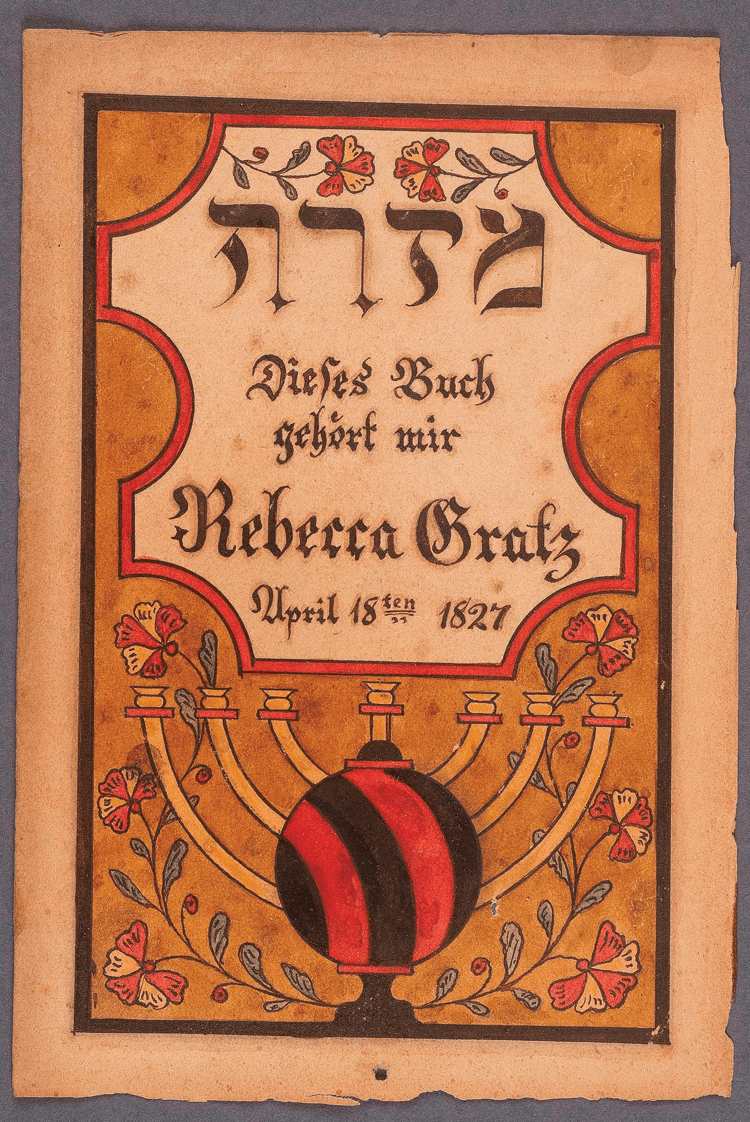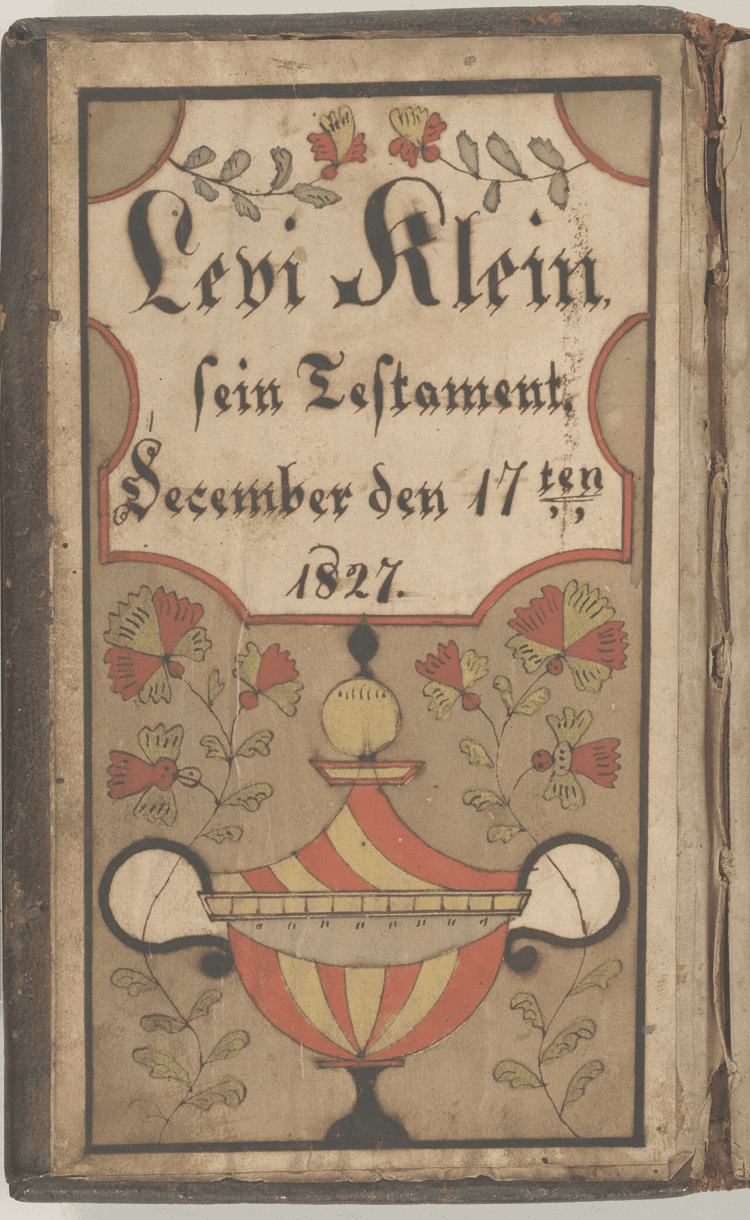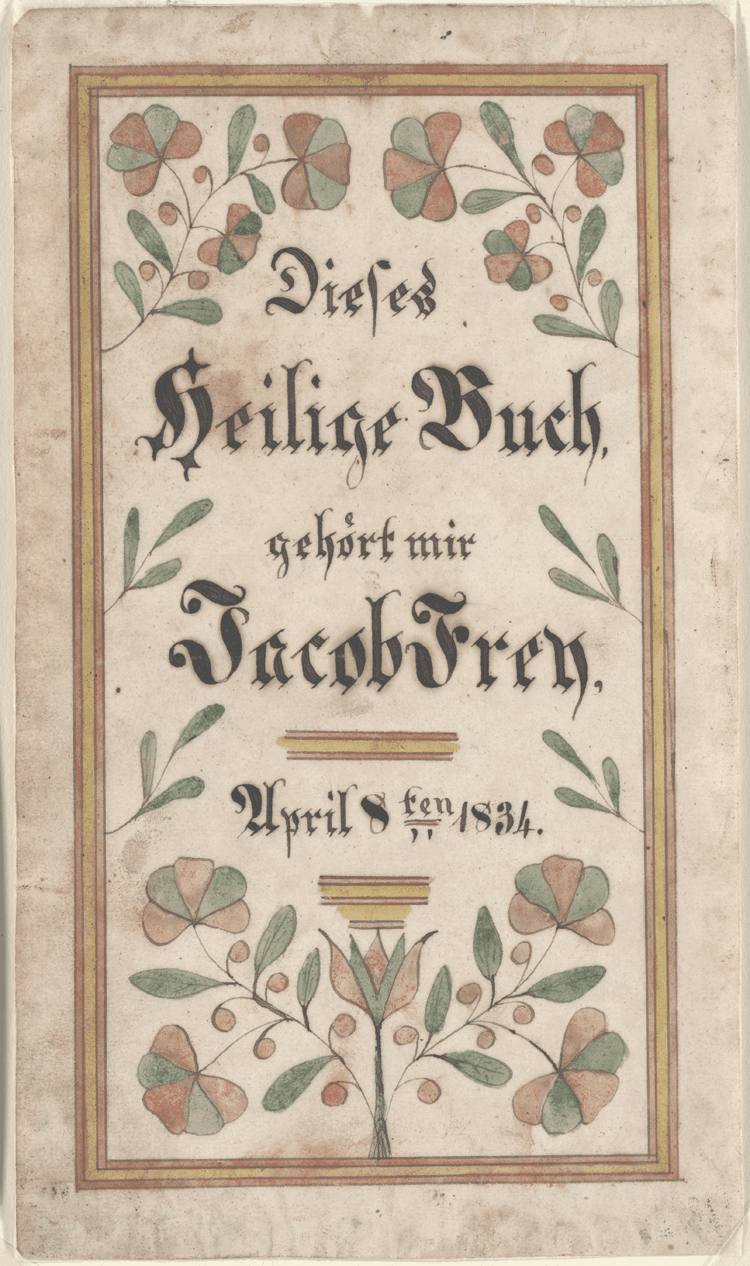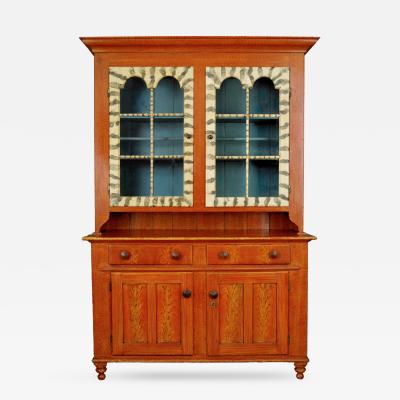Faux Fraktur: Too Good to be True
This archive article was originally published in the Summer 2014 issue of Antiques & Fine Art magazine.
Objects that are “too good to be true” are bound to surface from time to time. Such is the case with two fraktur recently determined to be spurious through a combination of visual examination, historical research, and scientific analysis. One has been in a major private collection since 1987; the other came to light in 2011 at auction.
The first is a bookplate inscribed for Jacob Frey and dated April 14, 1834 (Fig. 1). The abstract border designs, red-and-yellow flowers, and pointed leaves are all hallmarks of work by David Kulp, a Mennonite schoolmaster and fraktur artist who lived in Bucks County, Pennsylvania. Comparison of the bookplate with a nearly identical example firmly attributable to Kulp (Fig. 2), however, reveals that the handwriting on the two pieces is quite different. Rather than the narrow, vertical Fraktur lettering and slanted German script associated with Kulp’s work, the Jacob Frey bookplate is inscribed in strikingly different handwriting. As Kulp died in January 1834, the question arose as to whether he did the artwork and another person the inscription, or if the entire piece might be a fabrication.1
The second fraktur (Fig. 3) is in the style of Samuel Bentz, a schoolmaster and fraktur artist in Lancaster County, Pennsylvania. The bookplate is inscribed for Rebecca Gratz and dated April 18, 1827.2 The authenticity of a nearly identical bookplate, inscribed for Maria Gratz and dated 1821, was questioned when it appeared in a 1990 auction and was subsequently removed prior to the sale; its present whereabouts is unknown.3 The presence of a menorah-like candelabra (but with seven branches instead of nine) and the Hebrew word mizrach (east) suggest an association with the Jewish faith and that the fraktur uniquely functioned as both a bookplate and as a mizrach, a sign or plaque (often elaborately decorated) displayed in Jewish homes to indicate the direction of prayer toward Jerusalem. Rebecca Gratz (1781–1869), a renowned Jewish philanthropist and educator, was the daughter of Michael Gratz of Philadelphia and Miriam Simon of Lancaster Borough. Her maternal grandfather, Joseph Simon, was the leader of Lancaster Borough’s small Jewish community, which declined precipitously after his death in 1804. Given the unusual imagery on the fraktur and its purported ties to one of the most famous Jewish families in America, the authenticity of the Rebecca Gratz bookplate was closely scrutinized.
From the outset it was questioned why Rebecca Gratz, a wealthy Philadelphian with sophisticated urban tastes (portraits by Thomas Sully were among her household furnishings), would have owned a bookplate made by Samuel Bentz. Nearly all of Bentz’s known fraktur were made for people who lived in the area between Ephrata and Brickerville in northern Lancaster County. In addition, although Rebecca’s father, Michael Gratz, and his brother Barnard emigrated from Silesia, all of their known correspondence is in Yiddish and no evidence has been found to indicate that family members spoke, read, or wrote in German. Thus the likelihood of Rebecca Gratz owning a German-language bookplate or mizrach made by Samuel Bentz seems questionable at best. The only possible connection found thus far is a mizrach that has been attributed to Bentz and is said to have descended in the Etting family of Baltimore, who intermarried with the Gratzes and had Lancaster Borough connections.
During examination of the Gratz fraktur, we realized that the lettering and numerals were nearly identical to those on the dubious Jacob Frey bookplate. Given that Samuel Bentz worked in Lancaster County and David Kulp in Bucks County, this discovery raised more concerns about the authenticity of both pieces. Further research located an authentic Bentz bookplate of closely related design, with the exception of the Hebrew lettering and menorah (Fig. 4), which was, like the Kolb bookplate, in the collection of the Free Library of Philadelphia. Both were published as color plates in Henry S. Borneman’s 1953 study Pennsylvania German Bookplates. Borneman also noted but did not illustrate a bookplate made for Jacob Frey with inscription identical to that on the fraktur in figure 1, save for the date (April 8 rather than 14). In 1976, both of the bookplates were published again in the catalogue of the Free Library’s fraktur collection, along with the Jacob Frey bookplate Borneman had described (Fig. 5).4 Its inscription closely matches that on the spurious Frey bookplate and was likely substituted for David Kulp’s more complicated handwriting by the forger, who had ready access to images of authentic fraktur through these publications. These findings also suggested that both spurious pieces were made by the same hand.
Nondestructive elemental and molecular analysis of the frakturs’ pigments was performed using x-ray fluorescence and Raman spectroscopy respectively. The data revealed that the pigments were inconsistent with the palette of a nineteenth-century Pennsylvania German fraktur artist.5 In the Rebecca Gratz piece, the brown background should be a darkened/oxidized copper-based green pigment such as copper resinate or verdigris, but instead analysis revealed an iron-based brown pigment suggesting an attempt at artificial aging. In addition, the red pigments on fraktur are almost invariably red lead and/or vermilion, a mercury sulfide red. However, the red on the Rebecca Gratz fraktur is an organic red dye precipitated onto a barium sulfate support. Yellow petals in the Gratz fraktur were also found to contain a barium sulfate paint filler, never observed in the traditional fraktur artists’ palette. Finally, the green leaves in the Gratz fraktur were not copper-based greens (which explains why they have not oxidized to brown), but chromium-based green pigments that were rich in both zinc and barium. This suggests the presence of lithopone, a zinc and barium-based paint filler introduced in 1874 and not identified in fraktur. It is also notable that the format and quality of the paper used is more consistent with the type of paper found in nineteenth-century books than that expected for an illuminated manuscript such as a mizrach.
The spurious Frey bookplate was found to have a similar palette, with the red paint containing neither the mercury expected for vermilion nor the lead expected for minium (red lead), but rather barium and zinc, elements not part of the traditional Pennsylvania German fraktur palette and suggestive of an architectural paint with a lithopone filler (barium sulfate and zinc sulfide). In addition, the yellow paint contains a titanium-based filler/opacifier, a material not in use until the second decade of the twentieth century. A zinc oxide filler was also identified, a pigment used in watercolors since the second quarter of the nineteenth century, but not identified previously in fraktur.
New scrutiny of the bookplates also revealed more clues. The Gratz bookplate has several characteristics that suggest it is an old paper that was recently hand colored. One indication is that the color was more heavily absorbed in areas of “foxing” (where localized fungal and oxidative damage makes the paper more absorbent than the surrounding area), suggesting the paper had already undergone damage before it was colored, not after. The ink and coloring also has tide lines surrounding it, suggestive of the wet medium being absorbed by an aged sheet of paper, rather than the oxidation expected for iron gall inks, for example. Other areas of wet medium have penetrated to the verso, suggesting the sheet was not adequately sized (coated with gelatin), as would be expected of a writing paper traditionally used by a fraktur artist.
In addition, the paper appears to be a standard mid-to-late 1800s “Foolscap octavo” size (6 ¾ x 4 ¼ inches), and a fragment of what appears to be animal glue and leather at the upper right corner is consistent with it being a page removed from a book. The oxidation pattern on the sheet is also consistent with a piece of paper having spent most of its life bound in a book. The haloing around the letters, normally the result of acids and corrosive substances in the iron gall ink, also encircles them in a more symmetrical manner than usual (particularly visible around the letters in “Gratz.”). The thickness of the haloing is evenly distributed regardless of the thickness of the lettering/numerals themselves, which should not be the case as more oxidative haloing would be present where the lettering/numerals are thicker. The leaves on the Frey bookplate are also an even greenish-brown color, whereas slight variations typically occured as the copper-based green pigments oxidized over time.
The evidence suggests that whoever made these two faux fraktur was intimately familiar with original examples and painstakingly attempted to reproduce signs of aging and enhance the sense of authenticity. The visual and historical anomalies identified here called these pieces into question and scientific analysis confirmed these suspicions, demonstrating that a comprehensive understanding often requires the expertise of the connoisseur, the conservator, and the scientist.
Tips for Authenticating Fraktur
Examine both sides of the fraktur, if possible, to look for signs of age as well as any condition issues that may not be visible from the front. Does the ink show signs of “sinking” through the paper to the back side? Do the pigments have evidence of age such as craquelure? Is the type of paper consistent with the date of the fraktur (wove paper did not come into common use on fraktur until about 1820)?
Are the handwriting and motifs compatible with other fraktur by the same artist? If the piece is dated, is the date consistent with the artist’s life or working dates? Consult museum collections, books on fraktur, and the Free Library’s online database (libwww.freelibrary.org/fraktur) for comparative examples. Be extra cautious if the piece appears to be a close copy of a published or otherwise well-known fraktur (the cover of a book or auction catalogue, for example).
The most commonly faked fraktur are bookplates and other pieces that contain little to no writing, as Fraktur lettering and especially German script are particularly difficult to render. If possible, check that the text itself also makes sense. Some fake pieces contain obvious mistakes such as the presence of the feminine suffix—“in” or “en”—on masculine surnames. If a bookplate is still in situ, look for signs of ink and pigments transferred to adjacent pages that indicate a long-term presence. For larger fraktur, look for signs of age and use, such as fold lines or longitudinal creases and small tears along the edges that indicate the piece was rolled up for a long time.
When in doubt, have the pigments analyzed. It is much easier to obtain old paper than authentic pigments, and even the use of period-appropriate pigments will not produce the degradation phenomena expected.
Lisa Minardi is an assistant curator at Winterthur Museum, Garden, & Library. Jennifer L. Mass is senior scientist and director of the scientific research and analysis laboratory at Winterthur. The authors would like to thank Gordon Fine, president of the American Decorative Arts Forum of Northern California, for his encouragement of this research.
This article was originally published in the Summer 2014 issue of Antiques & Fine Art magazine, a digitized version of which is available on afamag.com. InCollect.com is a division of Antiques & Fine Art, AFAnews, and AFA Publishing.
2. On Bentz, see Frederick S. Weiser, “Samuel Bentz, the ‘Mount Pleasant Artist’,” Der Reggeboge: Journal of the Pennsylvania German Society 20, no. 2 (1986): 33–42.
3. The Maria Gratz bookplate is illustrated in Christie’s East, New York, American Furniture, Paintings and Decorative Arts, January 16, 1990, lot 272a.
4. Henry S. Borneman, Pennsylvania German Bookplates: A Study (Philadelphia: Pennsylvania German Society, 1953), frontispiece and pl. 3; Frederick S. Weiser and Howell J. Heaney, The Pennsylvania German Fraktur of the Free Library of Philadelphia, 2 vols. (Breinigsville, Pa: Pennsylvania German Society, 1976), vol. 1, fig. 183; vol. 2, figs. 368–369.
5. For technical studies of fraktur materials and techniques see: Janice H. Carlson and John Krill, “Pigment Analysis of Early American Watercolors and Fraktur’” Journal of the American Institute for Conservation 18, no. 1 (1978): 19–32; also Jennifer L. Mass, Catherine R. Matsen, and Janice H. Carlson, “Materials of the Pennsylvania German Fraktur Artist,” The Magazine Antiques vol. 168, no. 3 (September 2005): 128–135; and Richard R. Hark, Katelyn R. Houston, Jennifer Mass, Lisa Minardi, Hedwig T. Durnbaugh, and John Mumford, “Investigating the Juniata College Collection of Pennsylvania German Fraktur: Art Historical Perspectives and Scientific Analysis,” Juniata Voices 12 (2012): 102–125.






































